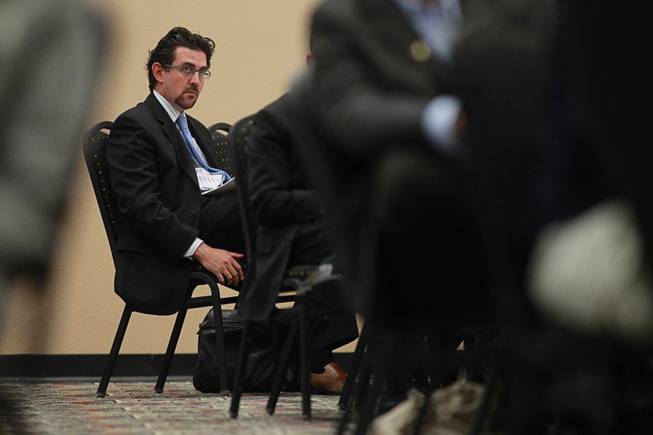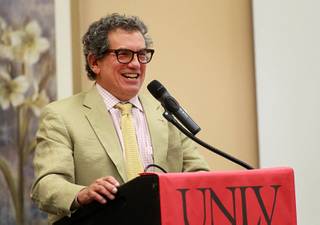
Jeremy Aguero, a principal analyst with Applied Analysis, listens to keynote speaker Roberto Suro, director of the Tomas Rivera Policy Institute at USC, as he waits to speak during the English Mastery for Nevada’s Prosperity education forum at the Stan Fulton Building on UNLV campus Thursday, June 21, 2012.
Saturday, June 23, 2012 | 2 a.m.
Sun coverage
Despite having one of the largest Hispanic student populations in the nation, Nevada allocates just $120 per pupil in federal funding to help English Language Learner students become proficient in English.
That’s not nearly enough funding to educate this challenging group of students, speakers at a local symposium on ELL students said this week.
“We don’t fund anything right,” said Jeremy Aguero, an economist with Applied Analysis, a Las Vegas-based economic research firm. “Some would say we’re conservative. Others would say we’re cheap.”
More than 50 educators, legislators, and business and community leaders attended Thursday’s conference, English Mastery for Nevada’s Prosperity, organized by the Nevada State Education Association.
Hispanic students are now the largest student group in the state, yet they are among the least likely to graduate from high school. Nevada’s graduation rate for Hispanic students in the class of 2008, the most recent data available, was a mere 29.6 percent.
A recent Education Week report on graduation rates projected that nearly 7,301 Hispanic students in Nevada did not graduate with the class of 2012 this month. Nationally, Latino students count for more than a quarter of the nation’s 1.1 million nongraduates, Education Week found.
“These statistics are compelling,” said Jeremy Aguero, founder of Applied Analysis. “For some of us, they’re frightening.”
Nearly a fifth of all Nevada students are considered English Language Learners, defined as students whose first language is not English, who live in a home where English is not spoken or who associate with peers in another language than English.
There are about 76,500 ELL students in Nevada, the overwhelming majority of whom are Hispanic with Spanish being the main language spoken, said Jonathan Gibson, an education programs professional with the Nevada education department.
About 90 percent of Nevada’s ELL students were born in the United States, Gibson added.
This language gap makes it difficult to teach students, a panel of teachers at the conference said. That language gap also extends to parents, which makes it difficult for schools to partner with parents to educate their children, they added.
“We need more resources,” a Washoe County schoolteacher said. “We’re stretched pretty thin.”
Compounding the problem is a high poverty rate among Hispanic families, teachers said. The lack of resources and language barrier puts poor Hispanic students at a disadvantage from their more affluent white peers, they said.
That has translated to poor academic performance among ELL students, Aguero said.
In Clark County, 31 percent of Limited English Proficient students are not proficient in math and 36 percent are not proficient in reading by fourth grade, he said.
Furthermore, 60 percent of ELL students in high school are credit deficient, complicating their chances of graduating, Gibson said. A little less than half of Nevada’s ELL students haven’t made enough progress and are considered long-term ELL students, snowballing the number of nonproficient students, he added.
Nevada hasn’t done enough to close this achievement gap, Aguero said. Nevada is one of four states that doesn’t allocate state funding to educate ELL students, he said.
Nevada receives just $119.47 in federal funding per ELL student to help them catch up with their English-speaking peers, Gibson said. That pot of money is expected to decrease by 9 percent next year, he added.
This federal money can’t be used to backfill budget cuts in other areas. Approved uses of this Title III money include professional development for English as a Second Language teachers, after-school programs, parent programs and supplemental materials.
Because Nevada doesn’t provide any additional funding for ELL students, cash-strapped school districts such as Clark County must subsidize the majority of services to help ELL students.
That means federally mandated screening tests for ELL students — about $23 per student — and staffing are paid by districts from dwindling general fund dollars, Gibson said.
With the Clark County School District facing multimillion-dollar budget cuts last year, district officials cut about 60 ELL facilitators. Through reallocation of resources, the district was able to staff either a literacy coach or an ELL specialist at all 217 elementary schools.
Despite the funding shortfall, there are lessons to be learned from top-performing schools in Las Vegas that serve a high population of minority students from low-income households, said Pedro Martinez.
The deputy superintendent of Clark County schools visited five elementary schools — Hewetson, McCall, Ollum, Wingert and Gene Ward — that are five-star elementary schools with high ELL populations. Martinez said these schools have several characteristics that help them succeed with ELL students.
All of these schools have strong principals and teachers who maintain high expectations of their students. The schools also use data to drive instruction and work hard to develop strong relationships with students and parents, he said.
The School District is now looking at bringing these qualities to scale among its 357 schools, Martinez said. Additional state resources would help, he said.
“Money is not everything,” Martinez said. “But resources matter.”
Gibson agreed.
“These numbers are totally alarming,” he said of ELL students’ low academic performance. “We have an urgent need to address these issues in Nevada.”
The conference at UNLV was sponsored by the state teachers union, Greenspun Media Group, the Latin Chamber of Commerce, News 3 and NV Energy.


Join the Discussion:
Check this out for a full explanation of our conversion to the LiveFyre commenting system and instructions on how to sign up for an account.
Full comments policy